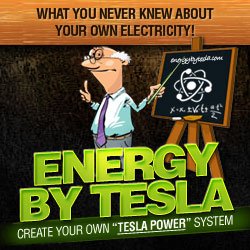 Nicola Tesla was a great inventor and engineer of the late 19th and early 20th century. He is the inventor of many processes necessary for alternating current, the type of electricity that has come to dominate all commercial electrical systems, replacing the direct current technology favored by Thomas Alva Edison. (Tesla was on the team of George Westinghouse, and Westinghouse and Edison were fierce rivals.)
Nicola Tesla was a great inventor and engineer of the late 19th and early 20th century. He is the inventor of many processes necessary for alternating current, the type of electricity that has come to dominate all commercial electrical systems, replacing the direct current technology favored by Thomas Alva Edison. (Tesla was on the team of George Westinghouse, and Westinghouse and Edison were fierce rivals.)
He was the chief inventor of radio. He contributed to the development of vertical takeoff and landing (VTOL) aircraft, wireless power transmission, the ocean thermal energy conversion method of producing electricity, and many more wonders. His is a name to conjure with.
Energy By Tesla Review
Little wonder, then, that as the price of electric power continues to climb, while the danger posed by human profligacy to the natural world rises with it, and interest in energy conservation and the production of renewable energy soars, the name of Nicola Tesla is arising once more in a context of electrical power. This is most especially appropriate considering the story of the Wardenclyffe Tower, a project that Tesla began in 1901.
The tower was built for the purposes of commercial trans-
Finally, the Wardenclyffe Tower project was abandoned when J. Pierpont Morgan, its main financier, withdrew his support, and all of Tesla’s notes were destroyed in a fire whose origins remain a mystery. All of these elements create an impression of a source of power developed by the Serbian genius, but denied to the world by the greed of a notorious robber baron whose name has become a synonym for unscrupulous rapacity.
One finds on the World Wide Web a number of plans for sale for devices that are alleged to produce “free energy” using principles discovered by Tesla but suppressed by the electric power industry. Of those, Energy By Tesla is one that openly uses the inventor’s name.
The asking price is just under $50, for which one receives plans for a device that can be constructed using a few hundred dollars’ worth of materials available from hardware and electronics stores. The company promises that the device will harness “radiant energy” from the Earth, the sun, or space to provide free electric power.
Nicola Tesla was a great inventor and engineer of the late 19th and early 20th century. He is the inventor of many processes necessary for alternating current, the type of electricity that has come to dominate all commercial electrical systems, replacing the direct current technology favored by Thomas Alva Edison. (Tesla was on the team of George Westinghouse, and Westinghouse and Edison were fierce rivals.)
He was the chief inventor of radio. He contributed to the development of vertical takeoff and landing (VTOL) aircraft, wireless power transmission, the ocean thermal energy conversion method of producing electricity, and many more wonders. His is a name to conjure with.
Energy By Tesla Review
Little wonder, then, that as the price of electric power continues to climb, while the danger posed by human profligacy to the natural world rises with it, and interest in energy conservation and the production of renewable energy soars, the name of Nicola Tesla is arising once more in a context of electrical power. This is most especially appropriate considering the story of the Wardenclyffe Tower, a project that Tesla began in 1901.
The tower was built for the purposes of commercial trans-
Finally, the Wardenclyffe Tower project was abandoned when J. Pierpont Morgan, its main financier, withdrew his support, and all of Tesla’s notes were destroyed in a fire whose origins remain a mystery. All of these elements create an impression of a source of power developed by the Serbian genius, but denied to the world by the greed of a notorious robber baron whose name has become a synonym for unscrupulous rapacity.
One finds on the World Wide Web a number of plans for sale for devices that are alleged to produce “free energy” using principles discovered by Tesla but suppressed by the electric power industry. Of those, Energy By Tesla is one that openly uses the inventor’s name.
The asking price is just under $50, for which one receives plans for a device that can be constructed using a few hundred dollars’ worth of materials available from hardware and electronics stores. The company promises that the device will harness “radiant energy” from the Earth, the sun, or space to provide free electric power.
This is a nice promise, but one’s skepticism is inevitably roused by the information –
What is lacking is any serious technical account of how the power is produced. It amounts to a sales pitch with no clear indication of just how the product’s features lead to the claimed benefits. One must pay a sum of money before one can find out exactly what it is one is buying.
While it’s impossible to deny the Vile Motives of Wicked Capitalism, especially in this day and age, neither should one overestimate the ability of the power companies to suppress truly revolutionary information in the context of the Internet.
If there really were a way to use a few hundred dollars’ worth of easily-
This is a nice promise, but one’s skepticism is inevitably roused by the information –
What is lacking is any serious technical account of how the power is produced. It amounts to a sales pitch with no clear indication of just how the product’s features lead to the claimed benefits. One must pay a sum of money before one can find out exactly what it is one is buying.
While it’s impossible to deny the Vile Motives of Wicked Capitalism, especially in this day and age, neither should one overestimate the ability of the power companies to suppress truly revolutionary information in the context of the Internet.
If there really were a way to use a few hundred dollars’ worth of easily-
